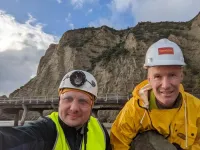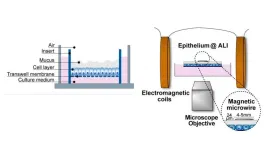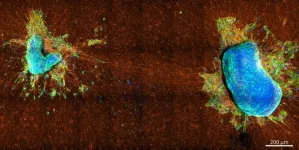(Press-News.org) COLUMBIA, Mo. (May 7, 2024) ― More Americans suffer from chronic pain than diabetes, heart disease, and cancer combined. Yet, a shortage of pain medicine specialists persists, causing many pain sufferers to seek care in primary care settings.
Researchers from the University of Missouri School of Medicine have found that an innovative tele-mentoring program can help address reliance on opioids in the management of pain, with potential benefits for patients, families and communities.
Project Extension for Community Healthcare Outcomes (ECHO) is an innovative educational and mentoring model where primary care providers and other clinicians connect with experts via videoconferencing. Tele-mentoring facilitates knowledge sharing between academic medical centers, medical specialists, and community primary care providers. There are currently 45 pain-related ECHO programs in the United States, including at the University of Missouri.
MU School of Medicine researchers found significant differences in opioid prescribing patterns of Pain Management ECHO participant medical providers compared to non-participating providers for patients enrolled in Missouri’s Medicaid program.
“We observed statistically significant differences in prescription dosages for patients whose providers consulted with Pain Management ECHO hub team specialists compared to non- participating providers,” said Mirna Becevic, PhD, assistant professor at the University of Missouri School of Medicine and lead project evaluator for the Show-Me ECHO. “ECHO participants’ patterns of lower rates of opioid proscribing reflects greater adherence to evidence-based recommendations and best practices in safe opioid prescribing.”
While prior studies have shown that provider participation in ECHO has promising impacts on patient care, the evidence is largely limited to case and observational studies. In this study, Becevic and her fellow researchers analyzed the opioid prescribing patterns of pain management ECHO participants.
Becevic worked on this study with fellow MU colleagues Olabode Ogundele, doctoral student; Xing Song, PhD, assistant professor of Biomedical Informatics; Praveen Rao, PhD, associate professor of electrical engineering and computer science; Suzanne Boren, PhD, professor at the College of Health Sciences; Tracy Greever-Rice, PhD, assistant research professor at the College of Health Sciences; Karen Edison, MD, senior medical director of the Missouri Telehealth Network; and Douglas Burgess, MD, a psychology professor at the University of Missouri-Kansas City.
Show-Me ECHO at the University of Missouri is part of the Missouri Telehealth Network. In addition to pain management, Show-Me ECHO programs include tele-mentoring for COVID-19, autism, dermatology and a variety of other health topics, including child health and behavioral health.
“We continue to find that Show-Me ECHO is a valuable tool for participating providers on a wide array of medical specialties,” said Becevic. “Linking providers in rural Missouri with medical specialists is an important element in the University of Missouri School of Medicine’s mission to save and improve lives, especially among underserved and vulnerable patient populations.”
“Claims Data Analysis of Provider-to-Provider Tele-mentoring Program Impact on Opioid Prescribing in Missouri” was recently published in the Journal of Opioid Management.
END
Telehealth program created to improve access to specialty care found to reduce reliance on opioids in pain management
Project ECHO continues to bridge health care gaps, especially in rural communities
2024-05-07
ELSE PRESS RELEASES FROM THIS DATE:
Advancing satellite-based PNT service: low earth orbit satellite constellations augment the GNSS
2024-05-07
A study has outlined the critical needs and essential technologies for a Low Earth Orbit (LEO) constellation to augment satellite navigation systems, significantly improving the Positioning, Navigation and Timing (PNT) services. This research specifically targets the diverse demands of different users for LEO augmented GNSS, the possible contribution of LEOs to PNT performances, and the key technologies referring to the LEO-based navigation augmentation system.
The Global Navigation Satellite Systems (GNSS), including the BeiDou Navigation Satellite System (BDS), are the most widely used in providing PNT services. However, GNSS signals from geostationary orbit (GEO), inclined ...
Researchers show that slow-moving earthquakes are controlled by rock permeability
2024-05-07
Earthquakes are the most dramatic and noteworthy results of tectonic plate movement. They are often destructive and deadly, or at the very least physically felt — they’re literally groundbreaking geological events. However not all tectonic movement results in effects that humans can perceive.
Slow slip events occur when pent up tectonic forces are released over the course of a few days or months, like an earthquake unfolding in slow motion. The more gradual movement means people won’t feel the earth shaking beneath their feet and buildings won’t collapse. But the lack of destruction does not make slow slip events less scientifically ...
Seeking medical insights in the physics of mucus
2024-05-07
WASHINGTON, May 7, 2024 – As much as we might not want to think about it, mucus is everywhere in our bodies. It coats our airways and our digestive systems and serves as a first line of defense against pathogens, a habitat for our microbiomes, and a conveyor belt for our insides to keep everything moving smoothly.
The front-line role of mucus means it is often the site of the first symptoms of infection or disease. Understanding how mucus changes, and what it changes in response to, can help diagnose illnesses and develop treatments. Designing a study to measure the physical properties of mucus, however, is nothing to sneeze at.
In APL Bioengineering, by AIP Publishing, ...
Study sheds light on cancer cell ‘tug-of-war’
2024-05-07
WASHINGTON, May 7, 2024 – Understanding how cancerous cells spread from a primary tumor is important for any number of reasons, including determining the aggressiveness of the disease itself. The movement of cells into the extracellular matrix (ECM) of neighboring tissue is an essential step in cancer progression that directly correlates to the onset of metastasis.
In APL Bioengineering, by AIP Publishing, a team of researchers from Germany and Spain used a breast cancer cell line panel and primary tumor explants from breast and cervical cancer patients to ...
Social determinants of health and the availability of cancer clinical trials in the US
2024-05-07
About The Study: Substantial geographic disparities in cancer clinical trials availability exist throughout the United States, with the most socially vulnerable counties being far less likely to have any trial and having only a fraction of trials available, a disparity that has worsened over time.
Corresponding Author: To contact the corresponding author, Rishi Robert Sekar, M.D., M.S., email rsekar@med.umich.edu.
To access the embargoed study: Visit our For The Media website at this link https://media.jamanetwork.com/
(doi:10.1001/jamanetworkopen.2024.10162)
Editor’s Note: Please ...
Multilevel characteristics of cumulative symptom burden in young survivors of childhood cancer
2024-05-07
About The Study: The findings of this study suggest that symptoms are prevalent years after young childhood cancer survivors’ initial cancer diagnosis, and interventions to reduce caregiver anxiety and neighborhood adversity and improve resilience may alleviate symptom burden.
Corresponding Author: To contact the corresponding author, I-Chan Huang, Ph.D., email i-chan.huang@stjude.org.
To access the embargoed study: Visit our For The Media website at this link https://media.jamanetwork.com/
(doi:10.1001/jamanetworkopen.2024.10145)
Editor’s Note: Please see the article for additional information, ...
Why getting in touch with our ‘gerbil brain’ could help machines listen better
2024-05-07
Macquarie University researchers have debunked a 75-year-old theory about how humans determine where sounds are coming from, and it could unlock the secret to creating a next generation of more adaptable and efficient hearing devices ranging from hearing aids to smartphones.
In the 1940s, an engineering model was developed to explain how humans can locate a sound source based on differences of just a few tens of millionths of a second in when the sound reaches each ear.
This model worked on the theory that we must ...
It flickers, then it tips – study identifies early warning signals for the end of the African humid period
2024-05-07
The transition from the African Humid Period (AHP) to dry conditions in North Africa is the clearest example of climate tipping points in recent geological history. They occur when small perturbations trigger a large, non-linear response in the system and shift the climate to a different future state, usually with dramatic consequences for the biosphere. That was also the case in North Africa, where the grasslands, forests, and lakes favored by humans disappeared, causing them to retreat to areas like the mountains, oases, and the Nile Delta. This ...
Aquatic weed among ‘world’s worst’ expands in Northeastern US
2024-05-07
WESTMINSTER, Colorado – 7 May 2024 – An article in the latest issue of Invasive Plant Science and Management provides new insights on a northern hydrilla (Hydrilla verticillata) subspecies (lithuanica) and its establishment outside the Connecticut River. Considered among the “world’s worst” aquatic weeds, northern hydrilla hinders recreational activities by forming dense canopies. If unchecked, it has the potential to displace native species and host a bacterium that produces ...
Emergency department packed to the gills? Someday, AI may help
2024-05-07
UCSF-led study finds artificial intelligence is as good as a physician at prioritizing which patients need to be seen first.
Emergency departments nationwide are overcrowded and overtaxed, but a new study suggests artificial intelligence (AI) could one day help prioritize which patients need treatment most urgently.
Using anonymized records of 251,000 adult emergency department (ED) visits, researchers at UC San Francisco evaluated how well an AI model was able to extract symptoms from patients’ ...
LAST 30 PRESS RELEASES:
Post-stroke injection protects the brain in preclinical study
Cardiovascular risk score predicts multiple eye diseases
Health: estimated one in ten British adults used or interested in GLP-1 medications for weight loss
Exercise to treat depression yields similar results to therapy
Whooping cough vaccination for pregnant women strengthens babies’ immune system
Dramatic decline in new cases of orphanhood in Uganda driven by HIV treatment and prevention programs
Stopping weight loss drugs linked to weight regain and reversal of heart health markers
Higher intake of food preservatives linked to increased cancer risk
Mass General Brigham–developed cholera vaccine completes phase 1 trial
First experimental validation of a “150-year-old chemical common sense” direct visualization of the molecular structural changes in the ultrafast anthracene [4+4] photocycloaddition reaction
Lack of support for people on weight loss drugs leaves them vulnerable to nutritional deficiencies, say experts
Dogs’ dinners can have greater climate impact than owners’
Are you ready to swap salmon for sprats and sardines?
1.6 million UK adults used weight loss drugs in past year
American College of Cardiology comments on new dietary guidelines for Americans
American Society of Gene & Cell Therapy and Orphan Therapeutics Accelerator partner to advance and commercialize promising rare disease treatments
One in 14 patients having day case surgery have new or worse chronic pain 3 months after their operation
New study highlights link between eviction rates and gun violence
Heatwaves heat up soil but not toxin levels in rice, study finds
Digital modeling reveals where construction carbon emissions really come from
Turning farm waste into water filters
New study shows how the spleen helps the immune system accept a transplant
New Mayo Clinic study advances personalized prostate cancer education with an EHR-integrated AI agent
Researchers identify novel therapeutic target to improve recovery after nerve injury
Microbes in breast milk help populate infant gut microbiomes
Reprogramming immunity to rewrite the story of Type 1 diabetes
New tool narrows the search for ideal material structures
Artificial saliva containing sugarcane protein helps protect the teeth of patients with head and neck cancer
Understanding the role of linear ubiquitination in T-tubule biogenesis
Researchers identify urban atmosphere as primary reservoir of microplastics
[Press-News.org] Telehealth program created to improve access to specialty care found to reduce reliance on opioids in pain managementProject ECHO continues to bridge health care gaps, especially in rural communities




